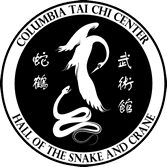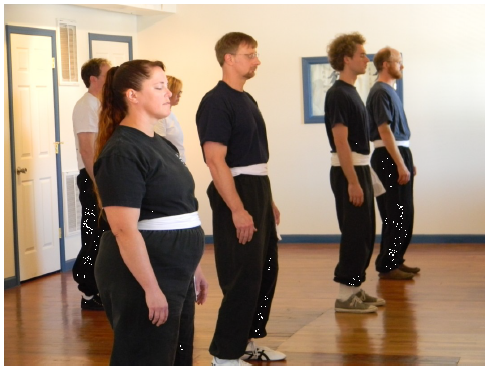What I Learned From Standing Meditation
By Barbara (Bobbie) Purvis
I recently set the goal to work up to 45 minutes of standing meditation after attending Mastery Class for the first time. The guest speaker, Qigong expert Mark Brophy, literally said almost word for word what Master Sbarge said in his workshop, and what Sifu has said (and continues to say) in class, “That of all the Qigong exercises, Standing Meditation is considered THE MOST IMPORTANT!”
According to Sifu at some point in our training, each of us will not only want to do this, but it will be supremely beneficial to us. Each time Sifu mentioned it in class, I noted it, and immediately relegated it to something that would happen later in my practice. Then at his workshop, Master Sbarge laid out a plan to make it happen. His suggestion was to work up to 30 minutes in a month. Simply start at the beginning of the month and add one minute each day. I had actual proof that this could work when Sifu shared that one of our class-mates, Junko Angel, had put Master Sbarge’s plan into action and completed it successfully. So, after hearing it for the third time at Mastery Class, I finally decided to give it a try.
I set the goal to work up to 45 minutes of Standing Meditation beginning on July 1st and ending on my birthday 45 days later. I decided to look at it as a gift to myself, although I wasn’t fully convinced that I could do it. As I remembered how long 5 or 10 minutes seemed as we stood at the beginning of class, I wondered how I would fare with multiple medical issues that involved my back, hip, and knee; and metabolic issues that affected my nutrition and energy. But as Sifu says, we must trust our teachers and learn to trust the process.
The first five days were simple, but even so, something curious happened. Much like class, standing in Wu Chi became the prelude to practice at home. Although I practiced regularly, standing meditation was something I would rarely do. But now, it was almost as if my spirit was saying practice would be especially good since I’d taken the time to clear my mind.
On day six, I noticed something else that was new — something that I hadn’t noticed in class. At about the six minute mark my body became warm — as though there was a fire burning within. It amazed me that an invisible force like Qi could work like that while I was standing still and simply relaxing.
Ten days in, I began to feel more energized, so much so that I decided to add daily qigong practice and created a 30 minute routine. By the end of the session on day twelve I was sweating so much it reminded me of when I use to run five miles a day, and I began to experience the same kind of endorphin rush at the end of the standing meditation session. Though it was getting tougher, presenting more of a challenge as the session got longer, that “just-finished-working-out” feeling made every bit of effort worth it. When I related what was happening at a doctor’s appointment during week two, my doctor said that most likely it was a sign that my metabolism was responding to the increased activity. All I could think was, Wow! Be-cause of various medical issues I’ve had an extremely sluggish metabolism and standing still was actually revving it back up.
Fifteen minutes felt like one of the longer sessions Sifu sometimes has us do in class. You know the ones where towards the end when you hear a door squeak or footsteps, and you’re hoping he’s coming in to start a new activity (like form practice, qigong exercises, or even a walking class}, and you were sure that if you’d had to go one minute more you wouldn’t have made it – but he does come in, so you do make it and feel good about the session.
I started to become a believer in the process after I completed 20 minutes, then worked up to 25. From about 25 minutes on it felt like my arms were resting on something solid beneath them and that I was seated on a stool that was the perfect height for me. At 30 minutes it was hard to believe that I’d come this far this fast. In the be-ginning, I’d wondered how I would make it to 45 minutes. Now, I was finding out.
At the 30 minute mark, I began to notice something curious about my ability to relax. It got easier. If you can remember what it feels like when your shoulders are tense and up around your ears when you first start to relax into the Wu Chi posture, well, I felt that same sensation at five minute intervals. It would feel like my shoulders had crept up, and I would relax them down. Another five minutes would pass and there would be that same sensation. But what was actually happening was that my body sensed that I would be holding that posture for a while – since that was now the pattern – and would move to a deeper level of relaxation and my shoulders relaxed down even more.
I made it through all 31 days of July and the first four days of August, 35 days/minutes all together, making good progress. Then something in my schedule changed, a medical issue flared a little and I had to take a break for a few days. So while this journey didn’t go exactly as planned, I believe the lessons learned did – and they continue since I’ve set a new goal to re-start my sessions beginning at 30 minutes, and continuing on to 45 minutes by the end of August.
Overall, the curious thing about doing the standing meditation was that the longer I stood, the more I practiced, and because of it, I have more energy and fewer health issues (or those that do arise are not as severe, or dissipate more quickly). Believe me when I say that 30 minutes is very do-able. But so is 45 minutes. It’s just a matter of setting the intention and following through — though it is harder to find larger blocks of uninterrupted time. But I am so much stronger for having made the attempt at 45 minutes – physically, mentally and emotionally, and for actually achieving over 30 minutes.
I truly understand the benefits of standing meditation now, and plan to continue to work a 30 or 40 minute session into my schedule at least once or twice a month. While I can’t say that my form is better, rather, I find it to be more comfortable. I feel more in synch with my body — and this is as it should be since that’s what the whole “mind-body connection” is all about.
–Barbara (Bobbie) Purvis is a retired Air Force Broadcast Journalist.


